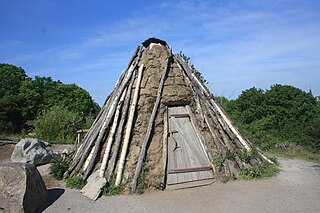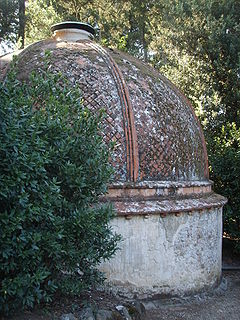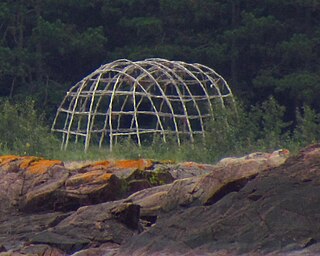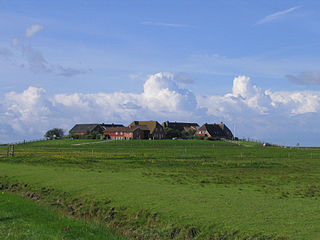 W
WThe field of Indigenous architecture refers to the study and practice of architecture of, for and by Indigenous people. It is a field of study and practice in the United States, Australia, Aotearoa New Zealand, Canada, Arctic area of Sápmi and many other countries where Indigenous people have a built tradition or aspire translate or to have their cultures translated in the built environment. This sometimes has been extended to landscape architecture, public art, placemaking and ways of contributing to the design of built environments.
 W
WAustralian architectural styles, like the revivalist trends which dominated Europe for centuries, have been primarily derivative.
 W
WA goahti, goahte, gåhte, gåhtie or gåetie, . Norwegian: gamme, Finnish: kota, Swedish: kåta), is a Sami hut or tent of three types of covering: fabric, peat moss or timber. The fabric-covered goahti looks very similar to a Sami lavvu, but often constructed slightly larger. In its tent version the goahti is also called a 'curved pole' lavvu, or a 'bread box' lavvu as the shape is more elongated while the lavvu is in a circular shape.
 W
WA hogan is the primary, traditional dwelling of the Navajo people. Other traditional structures include the summer shelter, the underground home, and the sweat house. A hogan can be round, cone-shaped, multi-sided, or square; with or without internal posts; timber or stone walls and packed with earth in varying amounts or a bark roof for a summer house, with the door facing east to welcome the rising sun for wealth and good fortune.
 W
WA humpy, also known as a gunyah, wurley, wurly or wurlie, is a small, temporary shelter, traditionally used by Australian Aboriginal people. These impermanent dwellings, made of branches and bark are sometimes called a lean-to, since they often rely on a standing tree for support.
 W
WAn Ice house, or icehouse, is a building used to store ice throughout the year, commonly used prior to the invention of the refrigerator. Some were underground chambers, usually man-made, close to natural sources of winter ice such as freshwater lakes, but many were buildings with various types of insulation.
 W
WAn igloo, also known as a snow house or snow hut, is a type of shelter built of snow, typically built when the snow is suitable.
 W
WThe Jean-Marie Tjibaou Cultural Centre, on the narrow Tinu Peninsula, approximately 8 kilometres (5.0 mi) northeast of the historic centre of Nouméa, the capital of New Caledonia, celebrates the vernacular Kanak culture, the indigenous culture of New Caledonia, amidst much political controversy over the independent status sought by some Kanaks from French rule. It opened in June 1998 and was designed by Italian architect Renzo Piano and named after Jean-Marie Tjibaou, the leader of the independence movement who was assassinated in 1989 and had had a vision of establishing a cultural centre which blended the linguistic and artistic heritage of the Kanak people.
 W
WA log cabin is a small log house, especially a less finished or architecturally sophisticated structure. Log cabins have an ancient history in Europe, and in America are often associated with first generation home building by settlers.
 W
WA marae, malaʻe, meʻae or malae is a communal or sacred place that serves religious and social purposes in Polynesian societies. In all these languages, the term also means cleared, free of weeds, trees. Marae generally consist of an area of cleared land roughly rectangular, bordered with stones or wooden posts perhaps with paepae (terraces) which were traditionally used for ceremonial purposes; and in some cases, a central stone ahu or a'u. In the Rapa Nui culture of Easter Island, the term ahu has become a synonym for the whole marae complex.
 W
WA platform mound is any earthwork or mound intended to support a structure or activity. It typically refers to a flat-topped mound, whose sides may be pyramidal.
 W
WA quiggly hole, also known as a pit-house or simply as a quiggly or kekuli, is the remains of an earth lodge built by the First Nations people of the Interior of British Columbia and the Columbia Plateau in the U.S. The word quiggly comes from kick willy or keekwulee, the Chinook Jargon word for "beneath" or "under".
 W
WA quinzhee or quinzee is a Canadian snow shelter that is made from a large pile of loose snow which is shaped then hollowed. This is in contrast to an igloo, which is built up from blocks of hard snow, and a snow cave, constructed by digging into the snow. The word is of Athabaskan origin, and entered the English language by 1984. A quinzhee can be made for winter camping and survival purposes, or for fun.
 W
WA sweat lodge is a low profile hut, typically dome-shaped or oblong, and made with natural materials. The structure is the lodge, and the ceremony performed within the structure may be called a purification ceremony or simply a sweat. Traditionally the structure is simple, constructed of saplings covered with blankets and sometimes animal skins. Originally, it was only used by some of the Indigenous peoples of the Americas, notably the Plains Indians, but with the rise of pan-Indianism, numerous nations that did not originally have the sweat lodge ceremony have adopted it. This has been controversial.
 W
WA temazcal is a type of low heat sweat lodge, which originated with pre-Hispanic Indigenous peoples in Mesoamerica. The term temazcal comes from the Nahuatl word temāzcalli [temaːsˈkalːi], or possibly from the Nahua words teme and calli (house).
 W
WA terp, also known as a wierde, woerd, warf, warft, werf, werve, wurt or værft, is an artificial dwelling mound found on the North European Plain that has been created to provide safe ground during storm surges, high tides and sea or river flooding. The various terms used reflect the regional dialects of the North European region. In English sources, terp appears to be by far the most common term used.
 W
WA tipi, also tepee or teepee and often called a lodge in older English writings, is a tent, traditionally made of animal skins upon wooden poles. Modern tipis usually have a canvas covering. A tipi is distinguished from other conical tents by the smoke flaps at the top of the structure.
Tipi: Home of the Nomadic Buffalo Hunters is an illustrated, non-fiction, young adult book by Caldecott-winning author and illustrator Paul Goble. It was published by World Wisdom Books in 2007.
 W
WThe Vernacular Architecture Forum (VAF) is a scholarly organization founded in 1980 to support the study and preservation of all aspects of vernacular architecture and landscapes. The organization has brought together scholars and practitioners from a wide variety of disciplines--geography, folklore, architecture, landscape architecture, historic preservation and others. The Vernacular Architecture Forum holds an annual meeting, conducts tours, and publishes the quarterly Vernacular Architecture Newsletter and the annual journal Buildings & Landscapes: Journal of the Vernacular Architecture Forum. In 2007, VAF had more than 800 members.
 W
WA wharenui is a communal house of the Māori people of New Zealand, generally situated as the focal point of a marae. Wharenui are usually called meeting houses in New Zealand English, or simply called whare.
 W
WA wigwam, wickiup, wetu, or wiigiwaam in the Ojibwe language, is a semi-permanent domed dwelling formerly used by certain Native American tribes and First Nations people. They are still used for ceremonial events. The term wickiup is generally used to label these kinds of dwellings in the Southwestern United States and Western United States, while wigwam is usually applied to these structures in the Northeastern United States as well as eastern Canada. Wetu is the Wampanoag term for a wigwam dwelling. These terms can refer to many distinct types of Native American structures regardless of location or cultural group. The wigwam is not to be confused with the Native Plains teepee, which has a very different construction, structure, and use.
 W
WWiltjas are shelters made by the Pitjantjatjara, Yankunytjatjara and other Aboriginal Australian peoples. They are temporary dwellings, and are abandoned and rebuilt rather than maintained. Open and semi-circular, wiltjas are meant primarily as a defence against the heat of the sun, and are not an effective shelter from rain.
 W
WA yaodong or "house cave" is a particular form of earth shelter dwelling common in the Loess Plateau in China's north. They are generally carved out of a hillside or excavated horizontally from a central "sunken courtyard".
 W
WA traditional yurt or ger (Mongolian) is a portable, round tent covered with skins or felt and used as a dwelling by several distinct nomadic groups in the steppes of Central Asia. The structure consists of an angled assembly or latticework of wood or bamboo for walls, a door frame, ribs, and a wheel possibly steam-bent. The roof structure is often self-supporting, but large yurts may have interior posts supporting the crown. The top of the wall of self-supporting yurts is prevented from spreading by means of a tension band which opposes the force of the roof ribs. Modern yurts may be permanently built on a wooden platform; they may use modern materials such as steam-bent wooden framing or metal framing, canvas or tarpaulin, plexiglass dome, wire rope, or radiant insulation.